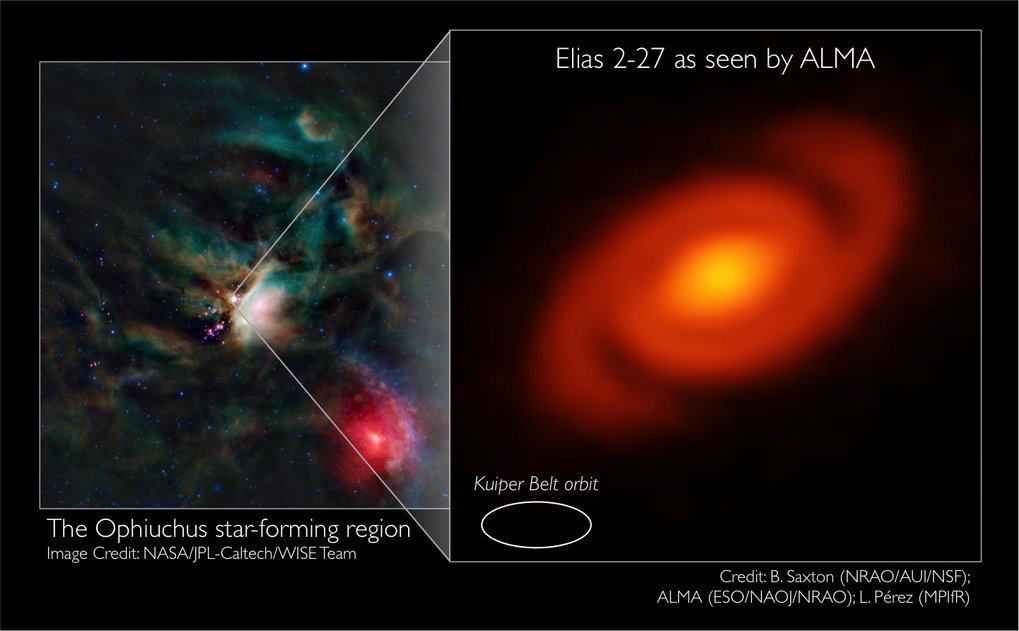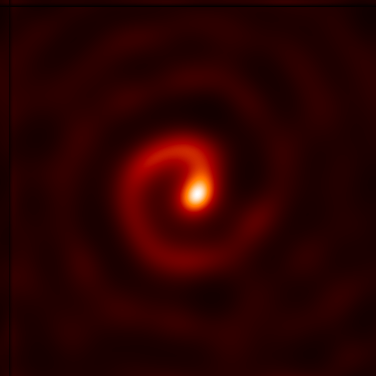Find out the latest thinking about our universe.
-
bystander
- Apathetic Retiree
- Posts: 21577
- Joined: Mon Aug 28, 2006 2:06 pm
- Location: Oklahoma
Post
by bystander » Fri Sep 30, 2016 4:02 pm
Spiral Arms: Not Just in Galaxies
Max Planck Institute for Radio Astronomy | 2016 Sep 29
Protoplanetary disk around a young star exhibits spiral structure
Astronomers have found a distinct structure involving spiral arms in the reservoir of gas and dust disk surrounding the young star Elias 2-27. While spiral features have been observed on the surfaces of protoplanetary disks, these new observations, from the ALMA observatory in Chile, are the first to reveal that such spirals occur at the disk midplane, the region where planet formation takes place. This is of importance for planet formation: structures such as these could either indicate the presence of a newly formed planet, or else create the necessary conditions for a planet to form. As such, these results are a crucial step towards a better understanding how planetary systems like our Solar system came into being.
An international team led by Laura Pérez, an Alexander von Humboldt Research Fellow from the Max Planck Institute for Radio Astronomy (MPIfR) in Bonn, also including researchers from the Max Planck Institute for Astronomy (MPIA) in Heidelberg, has obtained the first image of a spiral structure seen in thermal dust emission coming from a protoplanetary disk, the potential birthplace of a new solar system. Such structures are thought to play a key role in allowing planets to form around young stars. The researchers used the international observatory ALMA to image the disk around the young star Elias 2-27, in the constellation Ophiuchus, at a distance of about 450 light-years from Earth. ...
Spiral Arms Embrace Young Star
ALMA |
NRAO | ESO | NAOJ | 2016 Sep 29
Protostars Make Waves First, Planets Later
Rice University | 2016 Sep 29
Spiral Density Waves in a Young Protoplanetary Disk - Laura M. Pérez
et al
Know the quiet place within your heart and touch the rainbow of possibility; be
alive to the gentle breeze of communication, and please stop being such a jerk. — Garrison Keillor
-
geckzilla
- Ocular Digitator
- Posts: 9180
- Joined: Wed Sep 12, 2007 12:42 pm
- Location: Modesto, CA
-
Contact:
Post
by geckzilla » Fri Sep 30, 2016 7:14 pm
Now that's cool.
Just call me "geck" because "zilla" is like a last name.
-
Ann
- 4725 Å
- Posts: 13415
- Joined: Sat May 29, 2010 5:33 am
Post
by Ann » Sat Oct 01, 2016 5:03 am
Wikipedia wrote:
WR 104 is a triple star system located about 7,500 light years from Earth. The primary is a Wolf-Rayet star, with a B0.5 main sequence star in a close orbit and a more distant fainter star.
The WR star is surrounded by a distinctive Wolf–Rayet nebula, originally categorized as a pinwheel nebula and often referred to as the Pinwheel Nebula. The rotational axis of the binary system, and likely of the two closest stars, is directed approximately towards Earth. Within the next few hundred thousand years, the Wolf-Rayet star is predicted to explode as a core-collapse-supernova with a small chance of producing a long duration gamma-ray burst.
...
If a supernova from WR 104 is isotropic, its destructive consequences for the biosphere on Earth are predicted to be negligible. If it happens to be highly anisotropic however, there is a risk that it might cause significant harm, in particular because it is generally assumed that the rotational axis of both stars are orientated in the same way as the binary system, with an estimated (but uncertain) 12 degrees inclination relative to Earth. Anisotropic supernovae concentrate their radiative emissions in jet-cones along their rotational axis, so this face-on alignment makes WR 104 potentially dangerous. According to the data about WR 104, both supernovae are expected to be anisotropic.[10]
Regarding a GRB from WR 104 specifically, only sketchy estimates have been published so far. To predict the potential consequences for life on Earth, a proper determination of the rotational axis inclination relative to Earth is considered the most vital issue in this regard.[10] If a beam of high energy radiation from a nearby GRB hits Earth, model calculations shows that it can have destructive consequences for the ecosystems. The range of destruction depends on the magnitude and distance of the burst and on how much of the radiation beam hits. It is currently "highly unlikely" that a GRB from WR 104 will pose a danger to life on Earth.
Stars make waves not just when they are setting the stage for their future planets, but also when they prepare to go out with a bang.
Ann
Color Commentator
-
geckzilla
- Ocular Digitator
- Posts: 9180
- Joined: Wed Sep 12, 2007 12:42 pm
- Location: Modesto, CA
-
Contact:
Post
by geckzilla » Sat Oct 01, 2016 5:49 am
The protoplanetary disk is accretion and WR 104 is ejection, though?
Just call me "geck" because "zilla" is like a last name.
-
Ann
- 4725 Å
- Posts: 13415
- Joined: Sat May 29, 2010 5:33 am
Post
by Ann » Sat Oct 01, 2016 6:13 am
Well, why should nature invent the wheel - or the spiral - twice? One and the same shape serves many purposes.

Ann
Color Commentator

